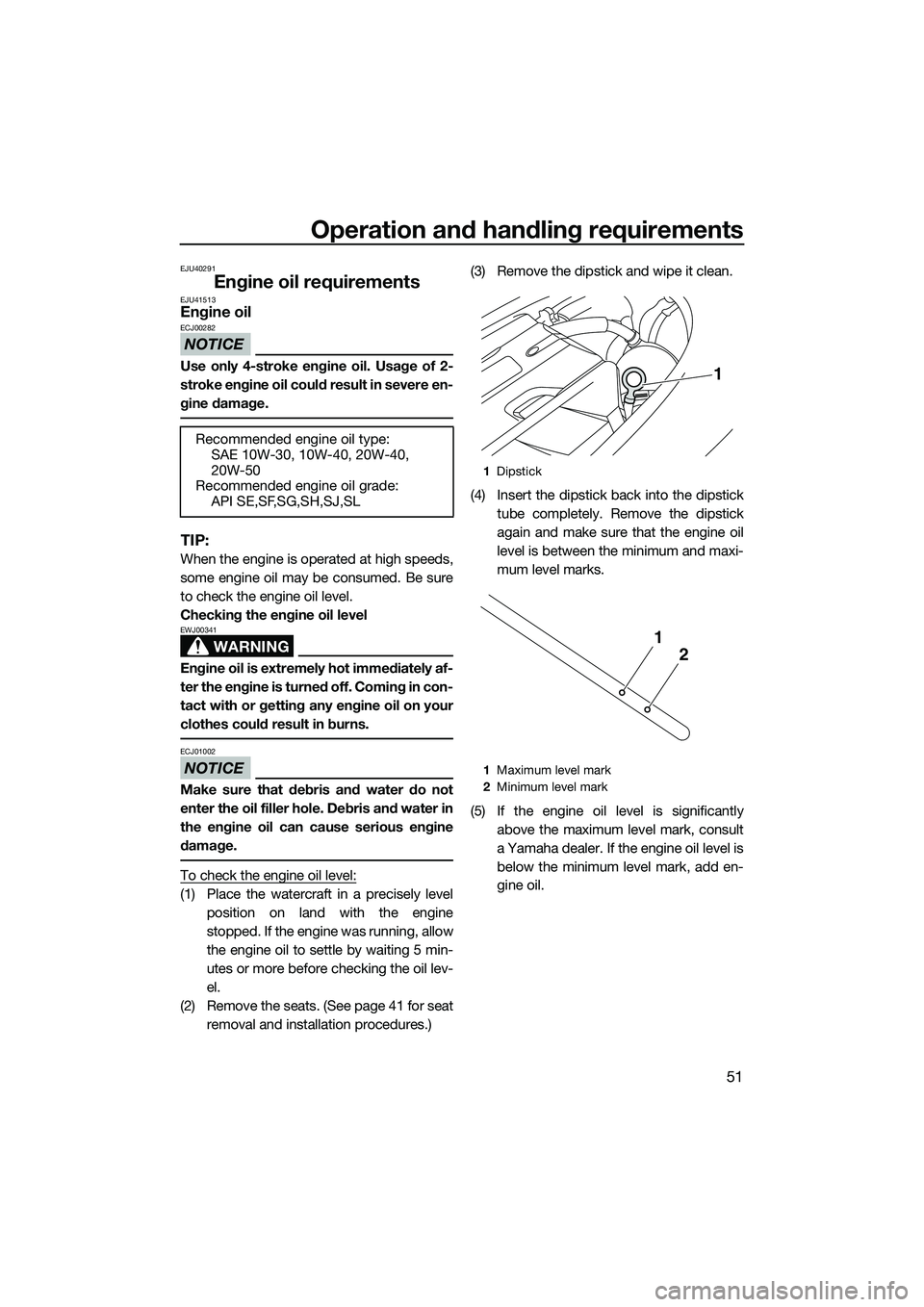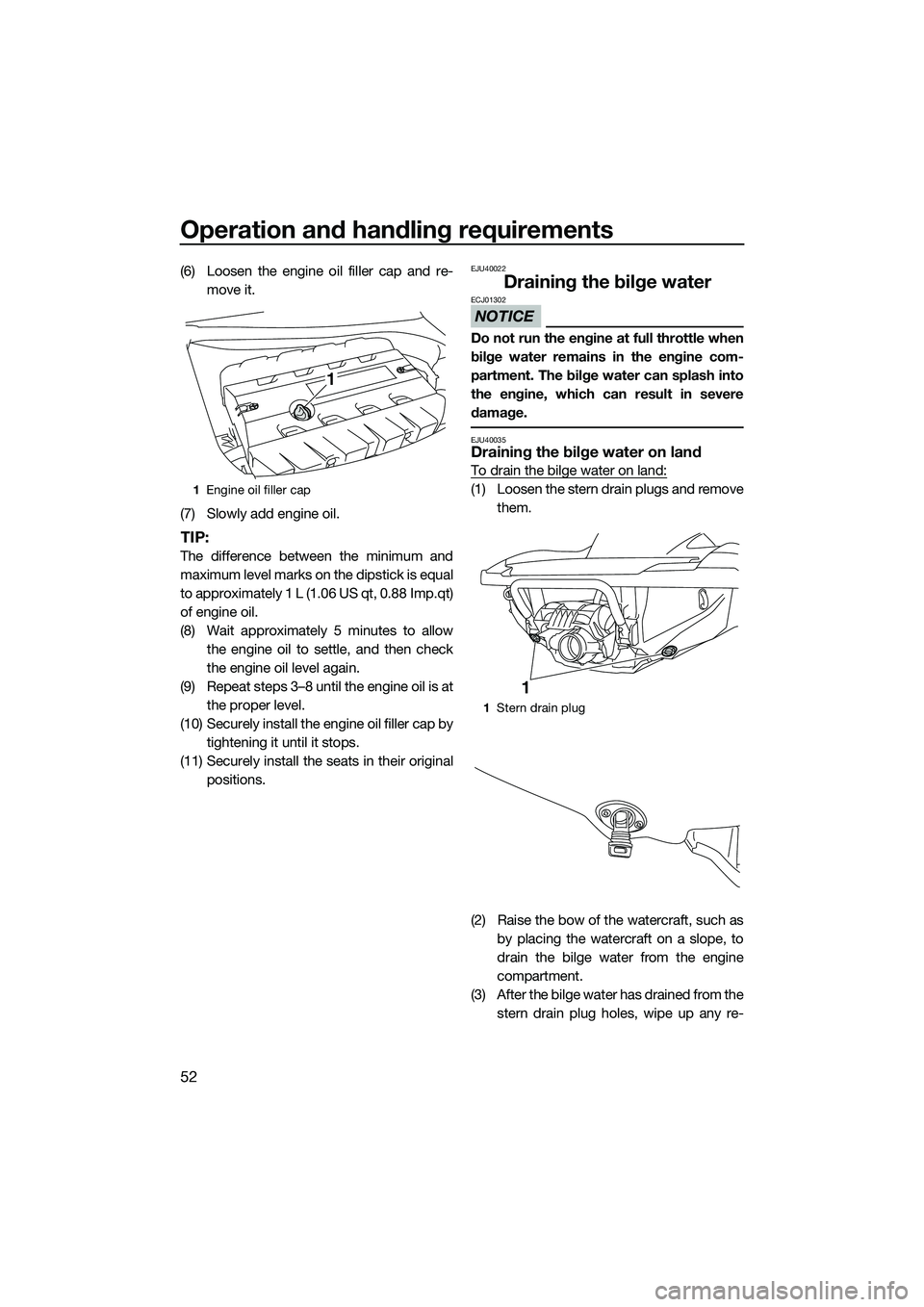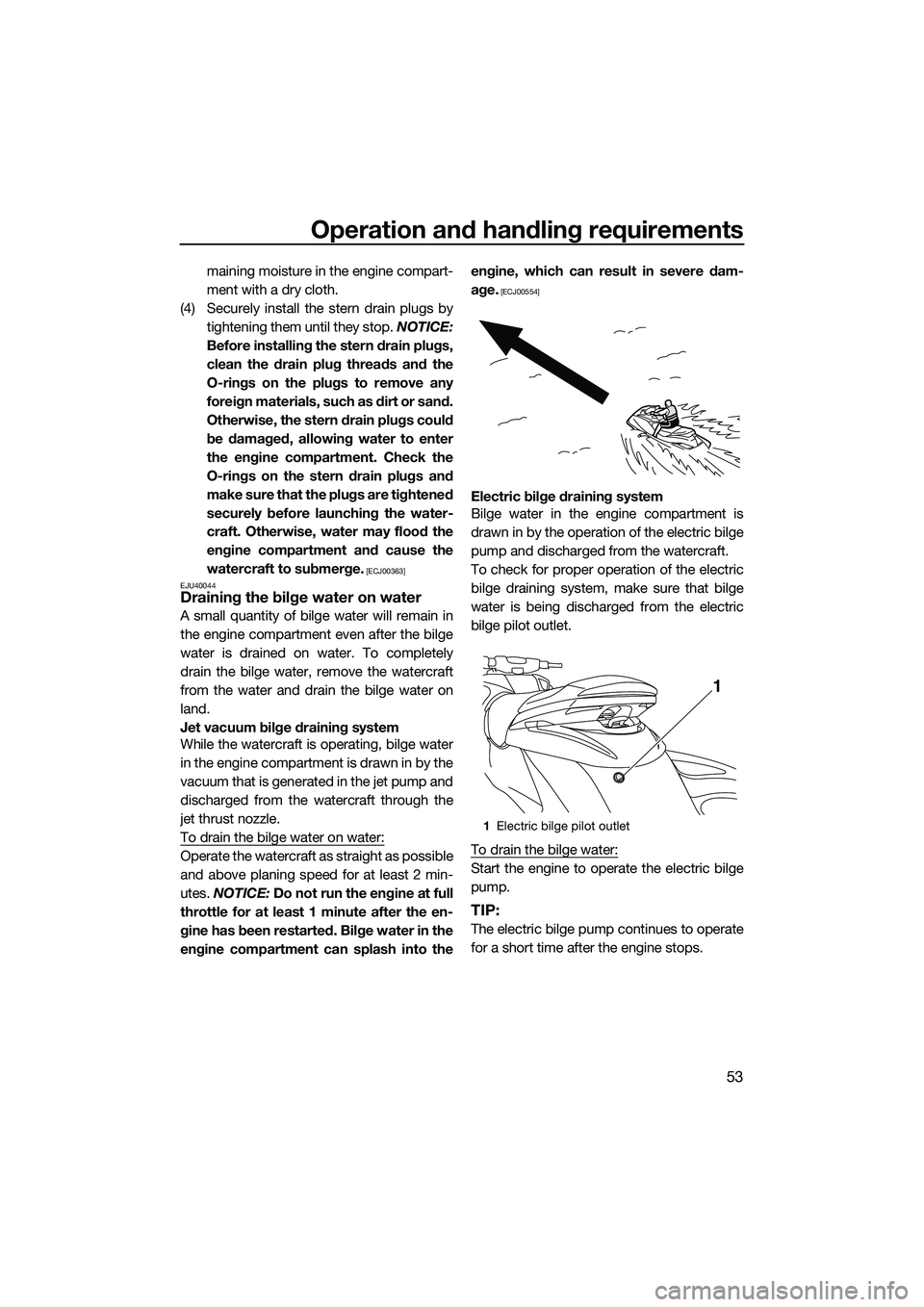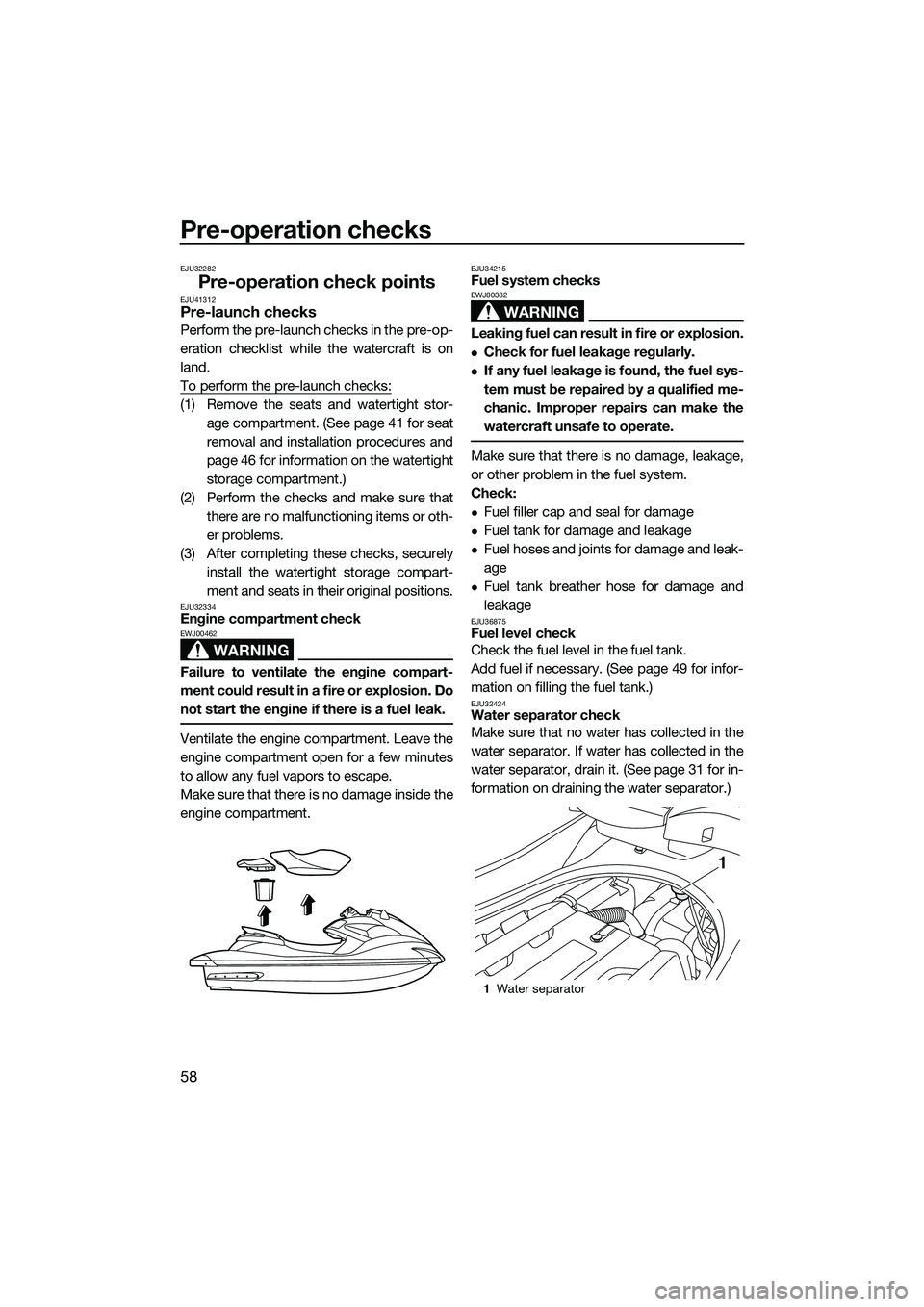Page 57 of 106

Operation and handling requirements
51
EJU40291
Engine oil requirementsEJU41513Engine oil
NOTICE
ECJ00282
Use only 4-stroke engine oil. Usage of 2-
stroke engine oil could result in severe en-
gine damage.
TIP:
When the engine is operated at high speeds,
some engine oil may be consumed. Be sure
to check the engine oil level.
Checking the engine oil level
WARNING
EWJ00341
Engine oil is extremely hot immediately af-
ter the engine is turned off. Coming in con-
tact with or getting any engine oil on your
clothes could result in burns.
NOTICE
ECJ01002
Make sure that debris and water do not
enter the oil filler hole. Debris and water in
the engine oil can cause serious engine
damage.
To check the engine oil level:
(1) Place the watercraft in a precisely levelposition on land with the engine
stopped. If the engine was running, allow
the engine oil to settle by waiting 5 min-
utes or more before checking the oil lev-
el.
(2) Remove the seats. (See page 41 for seat removal and installation procedures.) (3) Remove the dipstick and wipe it clean.
(4) Insert the dipstick
back into the dipstick
tube completely. Remove the dipstick
again and make sure that the engine oil
level is between the minimum and maxi-
mum level marks.
(5) If the engine oil level is significantly above the maximum level mark, consult
a Yamaha dealer. If the engine oil level is
below the minimum level mark, add en-
gine oil.
Recommended engine oil type:
SAE 10W-30, 10W-40, 20W-40,
20W-50
Recommended engine oil grade: API SE,SF,SG,SH,SJ,SL
1Dipstick
1 Maximum level mark
2 Minimum level mark
1
2
1
UF3K71E0.book Page 51 Monday, August 18, 2014 2:54 PM
Page 58 of 106

Operation and handling requirements
52
(6) Loosen the engine oil filler cap and re-move it.
(7) Slowly add engine oil.
TIP:
The difference between the minimum and
maximum level marks on the dipstick is equal
to approximately 1 L (1.06 US qt, 0.88 Imp.qt)
of engine oil.
(8) Wait approximately 5 minutes to allow the engine oil to settle, and then check
the engine oil level again.
(9) Repeat steps 3–8 until the engine oil is at the proper level.
(10) Securely install the engine oil filler cap by tightening it until it stops.
(11) Securely install the seats in their original positions.
EJU40022
Draining the bilge water
NOTICE
ECJ01302
Do not run the engine at full throttle when
bilge water remains in the engine com-
partment. The bilge water can splash into
the engine, which can result in severe
damage.
EJU40035Draining the bilge water on land
To drain the bilge water on land:
(1) Loosen the stern drain plugs and removethem.
(2) Raise the bow of the watercraft, such as by placing the watercraft on a slope, to
drain the bilge water from the engine
compartment.
(3) After the bilge water has drained from the stern drain plug holes, wipe up any re-1Engine oil filler cap
1
1Stern drain plug
1
UF3K71E0.book Page 52 Monday, August 18, 2014 2:54 PM
Page 59 of 106

Operation and handling requirements
53
maining moisture in the engine compart-
ment with a dry cloth.
(4) Securely install the stern drain plugs by tightening them until they stop. NOTICE:
Before installing the stern drain plugs,
clean the drain plug threads and the
O-rings on the plugs to remove any
foreign materials, such as dirt or sand.
Otherwise, the stern drain plugs could
be damaged, allowing water to enter
the engine compartment. Check the
O-rings on the stern drain plugs and
make sure that the plugs are tightened
securely before launching the water-
craft. Otherwise, water may flood the
engine compartment and cause the
watercraft to submerge.
[ECJ00363]
EJU40044
Draining the bilge water on water
A small quantity of bilge water will remain in
the engine compartment even after the bilge
water is drained on water. To completely
drain the bilge water, remove the watercraft
from the water and drain the bilge water on
land.
Jet vacuum bilge draining system
While the watercraft is operating, bilge water
in the engine compartment is drawn in by the
vacuum that is generated in the jet pump and
discharged from the watercraft through the
jet thrust nozzle.
To drain the bilge water on water:
Operate the watercraft as straight as possible
and above planing speed for at least 2 min-
utes. NOTICE: Do not run the engine at full
throttle for at least 1 minute after the en-
gine has been restarted. Bilge water in the
engine compartment can splash into the engine, which can result in severe dam-
age.
[ECJ00554]
Electric bilge draining system
Bilge water in the engine compartment is
drawn in by the operation of the electric bilge
pump and discharged from the watercraft.
To check for proper operation of the electric
bilge draining system, make sure that bilge
water is being discharged from the electric
bilge pilot outlet.
To drain the bilge water:
Start the engine to operate the electric bilge
pump.
TIP:
The electric bilge pump continues to operate
for a short time after the engine stops.
1
Electric bilge pilot outlet
1
UF3K71E0.book Page 53 Monday, August 18, 2014 2:54 PM
Page 60 of 106
Operation and handling requirements
54
EJU33465
Transporting on a trailer
When transporting the watercraft on a trailer,
secure the tie downs to the trailer through the
bow eye and stern eyes. NOTICE: Do not at-
tach ropes or tie downs to any part of the
watercraft other than the bow eye and
stern eyes to secure the watercraft to the
trailer. Otherwise, the watercraft may be
damaged. Wrap the ropes or tie downs
with towels or rags where they touch the
body of the watercraft to avoid scratches
or damage. Do not transport the water-
craft with the shift lever in the reverse po-
sition. Otherwise, the reverse gate may hit
an obstacle, which could cause damage.
[ECJ00645]
UF3K71E0.book Page 54 Monday, August 18, 2014 2:54 PM
Page 61 of 106
First-time operation
55
EJU42690
Engine break-in
NOTICE
ECJ00432
Failure to perform the engine break-in
could result in reduced engine life or even
severe engine damage.
The engine break-in is essential to allow the
various components of the engine to wear
and polish themselves to the correct operat-
ing clearances. This ensures proper perfor-
mance and promotes longer component life.
To perform the engine break-in:
(1) Check the engine oil level. (See page 51for information on checking the engine
oil level.)
(2) Launch the watercraft and start the en- gine. (See page 68 for information on
starting the engine.)
(3) For the first 5 minutes, operate with the engine speed at 2000 r/min.
(4) For the next 90 minutes, operate with the engine speed below 5000 r/min.
After the engine break-in is complete, the wa-
tercraft can be operated normally.
UF3K71E0.book Page 55 Monday, August 18, 2014 2:54 PM
Page 62 of 106

Pre-operation checks
56
EJU31982
WARNING
EWJ00412
Failure to inspect or maintain the watercraft properly increases the possibility of an ac-
cident or damage to the watercraft. Do not operate the watercraft if you find any prob-
lem. If a problem cannot be corrected by the procedures provided in this manual, have
the watercraft inspected by a Yamaha dealer.
EJU41234Pre-operation checklist
Before using this watercraft, be sure to perform the checks in the following checklist.
ITEMROUTINEPAGE
PRE-LAUNCH CHECKS
Engine compartment Ventilate the engine compartment.
Check inside the engine compartment for damage.
58
Fuel system Check the fuel system for leakage.
Check the fuel level in the fuel tank.
58
Water separator Check the water separator for water. 58
Engine unit Check the exterior of the engine unit for damage. 59
Engine oil level Check the engine oil level. 59
Bilge water Check the engine compartment for bilge water. 59
Battery Check the battery connections and electrolyte level. 59
Steering system Check the steering system for proper operation. 60
Telescopic steering system Check the telescopic steering system for proper op-
eration and check that the handlebars are securely
locked in place. 61
Q.S.T.S. Check the Q.S.T.S. for proper operation and check
that the Q.S.T.S. selector is securely locked in
place. 61
Reverse system Check the reverse system for proper operation. 61
Throttle lever Check the throttle lever for proper operation.
Check the throttle lever free play.
62
Remote control transmitter Check the remote control transmitter for proper op-
eration.
62
Engine shut-off cord (lan-
yard) Check the engine shut-off cord (lanyard) for dam-
age.
63
Switches Check the start switch, engine stop switch, and en-
gine shut-off switch for proper operation.
63
Storage compartments Check the storage compartments for damage and
water.
63
Fire extinguisher holder,
cover, and band Check the fire extinguisher holder, cover, and band
for damage.
64
Fire extinguisher Check the condition of the fire extinguisher. 64
UF3K71E0.book Page 56 Monday, August 18, 2014 2:54 PM
Page 63 of 106
Pre-operation checks
57
TIP:
To ensure safety and reliability, pre-operation checks should be made each time the water-
craft is used.
Safety equipment Check that safety equipment meeting the applica-
ble regulations is on board.
64
Hull and deck Check the hull and deck for damage. 64
Jet intake Check the jet intake for damage and clogging. 64
Stern drain plugs Check the stern drain plugs for damage and foreign
material and check that they are securely installed.
64
Hood Check that the hood is securely closed. 65
Front and rear seats Check that the seats are securely installed. 41
POST-LAUNCH CHECKS
Cooling water pilot outlet Check that water is discharged from the port (left)
cooling water pilot outlet while the engine is run-
ning. 65
Dual analog meter unit Check the dual analog meter unit for proper opera-
tion.
65
Engine idling speed Check the engine idling speed. 66
ITEM ROUTINE PAGE
UF3K71E0.book Page 57 Monday, August 18, 2014 2:54 PM
Page 64 of 106

Pre-operation checks
58
EJU32282
Pre-operation check pointsEJU41312Pre-launch checks
Perform the pre-launch checks in the pre-op-
eration checklist while the watercraft is on
land.
To perform the pre-launch checks:
(1) Remove the seats and watertight stor-age compartment. (See page 41 for seat
removal and installation procedures and
page 46 for information on the watertight
storage compartment.)
(2) Perform the checks and make sure that there are no malfunctioning items or oth-
er problems.
(3) After completing these checks, securely install the watertight storage compart-
ment and seats in their original positions.
EJU32334Engine compartment check
WARNING
EWJ00462
Failure to ventilate the engine compart-
ment could result in a fire or explosion. Do
not start the engine if there is a fuel leak.
Ventilate the engine compartment. Leave the
engine compartment open for a few minutes
to allow any fuel vapors to escape.
Make sure that there is no damage inside the
engine compartment.
EJU34215Fuel system checks
WARNING
EWJ00382
Leaking fuel can result in fire or explosion.
Check for fuel leakage regularly.
If any fuel leakage is found, the fuel sys-
tem must be repaired by a qualified me-
chanic. Improper repairs can make the
watercraft unsafe to operate.
Make sure that there is no damage, leakage,
or other problem in the fuel system.
Check:
Fuel filler cap and seal for damage
Fuel tank for damage and leakage
Fuel hoses and joints for damage and leak-
age
Fuel tank breather hose for damage and
leakage
EJU36875Fuel level check
Check the fuel level in the fuel tank.
Add fuel if necessary. (See page 49 for infor-
mation on filling the fuel tank.)
EJU32424Water separator check
Make sure that no water has collected in the
water separator. If water has collected in the
water separator, drain it. (See page 31 for in-
formation on draining the water separator.)
1Water separator
1
UF3K71E0.book Page 58 Monday, August 18, 2014 2:54 PM
 1
1 2
2 3
3 4
4 5
5 6
6 7
7 8
8 9
9 10
10 11
11 12
12 13
13 14
14 15
15 16
16 17
17 18
18 19
19 20
20 21
21 22
22 23
23 24
24 25
25 26
26 27
27 28
28 29
29 30
30 31
31 32
32 33
33 34
34 35
35 36
36 37
37 38
38 39
39 40
40 41
41 42
42 43
43 44
44 45
45 46
46 47
47 48
48 49
49 50
50 51
51 52
52 53
53 54
54 55
55 56
56 57
57 58
58 59
59 60
60 61
61 62
62 63
63 64
64 65
65 66
66 67
67 68
68 69
69 70
70 71
71 72
72 73
73 74
74 75
75 76
76 77
77 78
78 79
79 80
80 81
81 82
82 83
83 84
84 85
85 86
86 87
87 88
88 89
89 90
90 91
91 92
92 93
93 94
94 95
95 96
96 97
97 98
98 99
99 100
100 101
101 102
102 103
103 104
104 105
105






